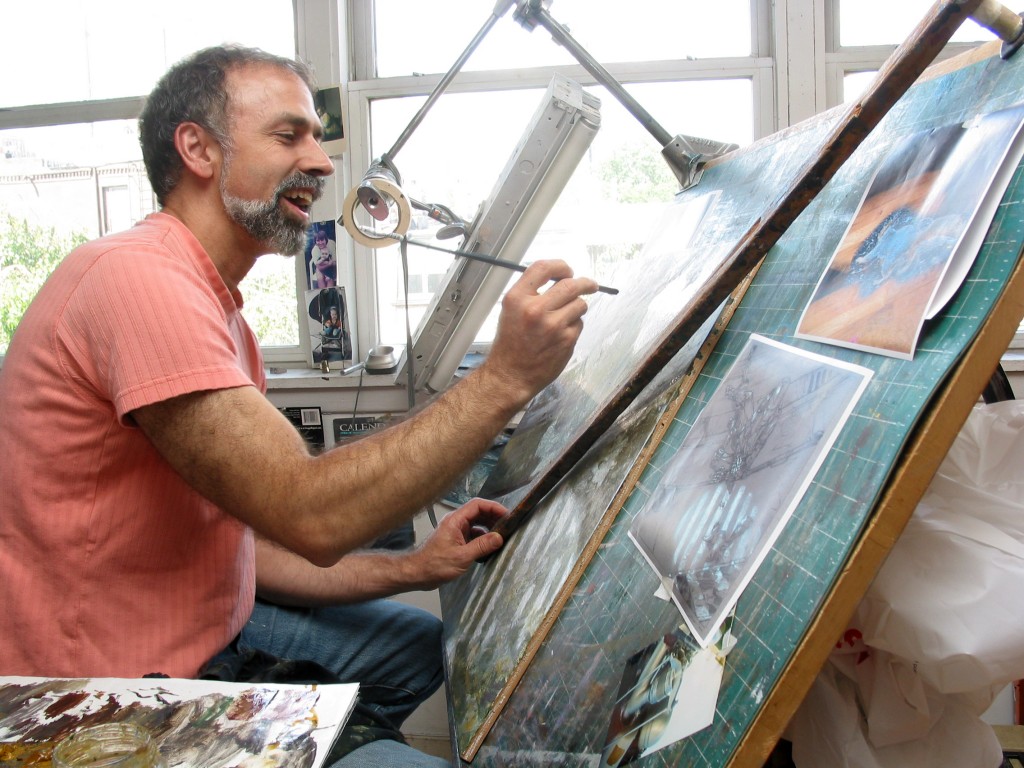The air grows colder, the occasional snowflake falls, and the Mirror Gallery opens again with another new piece of original Magic art. The sketch we are looking at today was acquired by a combination of chance, luck, and just plain serendipity. I’d like to start with a story.
October 2017: My first Illuxcon. I had never been, I didn’t really know anyone, and to be honest I always have had trouble starting conversations. But I had a well-loved Doomsday Specter in my box of cards to get signed, the one I traded for as a kid because it was my favorite art in all of Magic. I went to Donato Giancola’s booth and waited for him to finish his conversation. I don’t remember exactly what I said, but on the inside teenager Donny was having a panic attack, having his favorite Magic card signed by the artist. We spoke for a few minutes about Magic and Illuxcon, and I told Donato that one day I hoped to own one of his Magic originals. It turned out that day would be closer than I thought.
May 2018: Right on the heel of his Serra Angel, Donato Giancola’s Basic Land panorama is released as a set of five Grand Prix promotional cards. Painted as a single piece, the final painting sold immediately within hours of its preview. Four different traditional sketch drawings were done, and the three alternates not used for the final composition were made available for purchase. A friend and fellow collector clued me in as he bought one, and the fate of the other two remained unknown.

Basic Land Panorama by Donato Giancola. Traditional in Oils. Private Collection.
October 2018: My second Illuxcon. I had a small stack of cards for Donato to sign, and we once again spent a few minutes talking about his latest Magic cards and his upcoming Lord of the Rings compendium. I asked if he had any Magic related art remaining, and mentioned the panorama sketches. He answered “I think maybe one and a few other things” and that if I could send a follow up email he would include everything he had left. For those of you who haven’t had a chance to meet or interact with Donato, he is one of the warmest and friendliest humans I’ve ever met. We’ve shared ten minutes of conversation and a handful of emails over the last two years, but yet in person every meeting is as if you’re an old friend.
I told you that story to tell you this story: Donato did have one of the panorama sketches remaining, and it was certainly not the one I expected. I emailed him a week or so later to thank him for signing my cards and the great conversation, but also not forgetting to see exactly what Magic art remained in his studio. Thank you emails are something I have always done, especially when someone has made time for me. The email included some of the art you’ll see at the end of this article, and this piece:

Basic Land Panorama #4 by Donato Giancola, 2017, red watercolor pencil and chalk on toned grey ground, 8” x 24”
Labeled “#4” it looked incredibly similar to the finished work, save for the swamp and the forest on the far left being reversed. I got extremely excited. Could the one remaining be the final sketch? I messaged the aforementioned friend that purchased one of the others, and at the same time I emailed Donato, both to confirm what I thought I was seeing. It was in fact the final traditional sketch for his land panorama (further changes were made digitally for approval), and was now, for whatever reason, available to purchase; an opportunity born out of a simple thank you email and friendly conversation.
As an aside, as I was writing this article, the other two preliminaries turned out to still be hiding in Donato’s portfolio and became available on December 7th, 2018 via the MTG Art Market. They sold in less than five minutes.
In just a bit we’ll look closer at this wonderful piece of art, but first let’s meet the man behind the brush.
The Artist
Donato Giancola began his pursuit of a professional career in art at age 20, though he himself will tell you he’s drawn and created for as long as he can remember. At IlluxCon, he has always brought some of his earliest illustrations, from Star Wars recreations to custom Dungeons and Dragons map, all from his childhood and displayed right alongside his current work. Upon graduating from Syracuse University in 1992, he took those once humble drawings a step further, first as studio assistant to artist Vincent Desiderio and then beginning his professional career in 1993. From then on, the rest is imaginative realist history.
You can read his full biography from his website, and for a great interview with Donato, see Patrick Scalisi’s 2015 article “Stories with Brushstrokes.” You can also glean some background on his infamous “hand work” in my article “Powerstone Shard and Hand Artistry” from April 2018.
Giancola, or “Donny Cola” as he is affectionately known on Twitter and amongst some of the Magic crowd, has created 125 illustrations for Magic since 1996, beginning with Amber Prison:
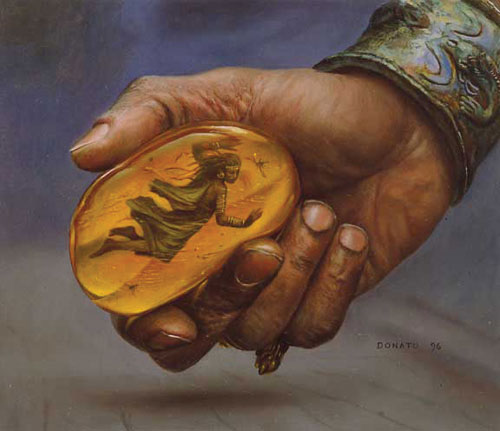
Amber Prison by Donato Giancola, 1996, oil on paper on masonite, 11.25” x 9.75”
And since including an exceptional amount of notable cards and characters, from Shivan Dragon and Serra Angel:
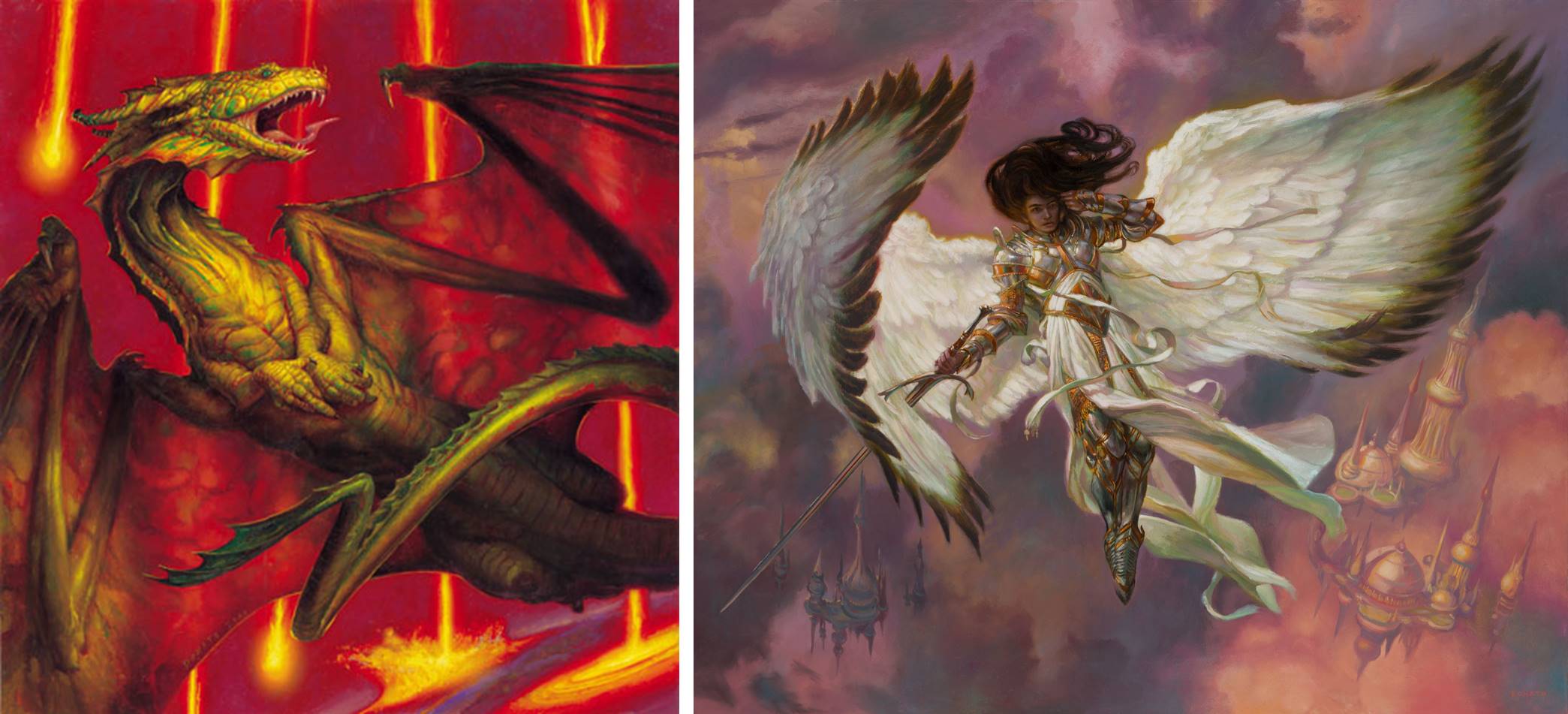
Left: Shivan Dragon by Donato Giancola, 2001, oil on paper on panel, 19” x 18” Right: Serra Angel by Donato Giancola, 2017, oil on panel, 24” x 30”
To the Mirari and Chrome Mox:
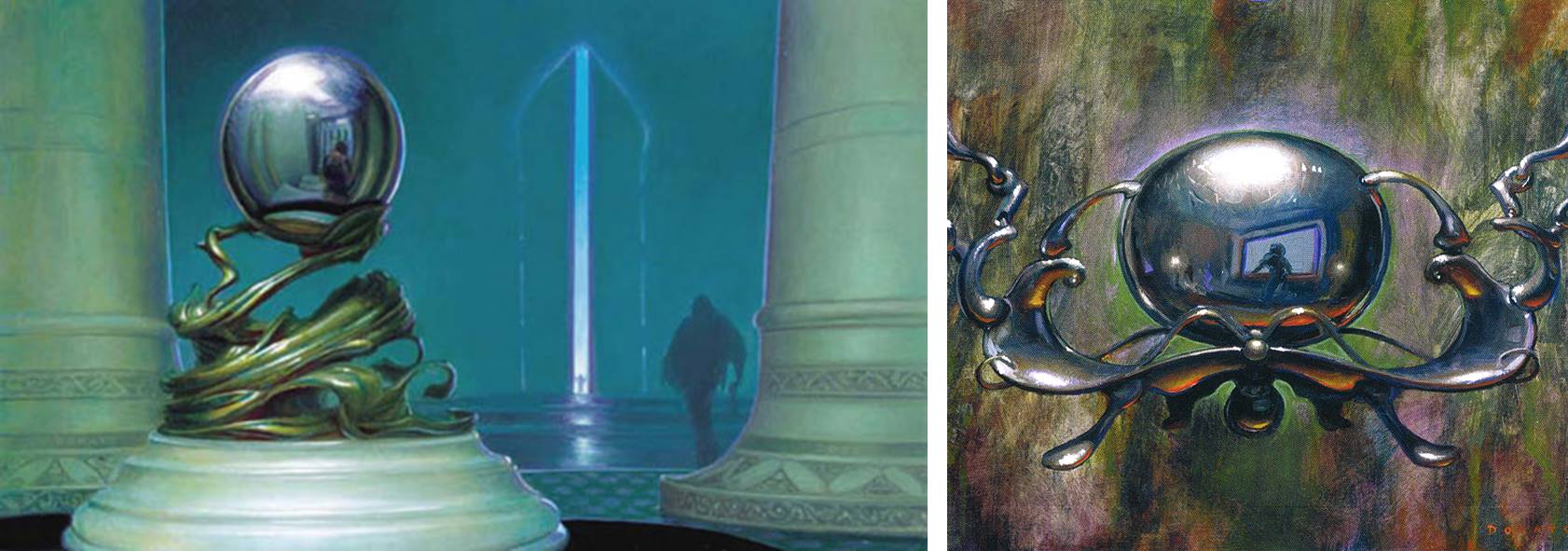
Left: Mirari (Orb of Desire) by Donato Giancola, 2001, oil on paper on masonite, 17” x 11” Right: Chrome Mox by Donato Giancola, 2002, traditional
Magic art guru Vorthos Mike Linnemann cites his Cartographer as the greatest artwork to ever be created for the game:
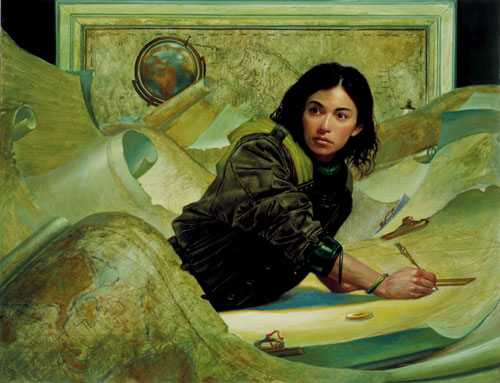
Cartographer by Donato Giancola, 2001, oil on paper on masonite, 22” x 17”
And my personal favorite, as you all heard earlier, is his Doomsday Specter:
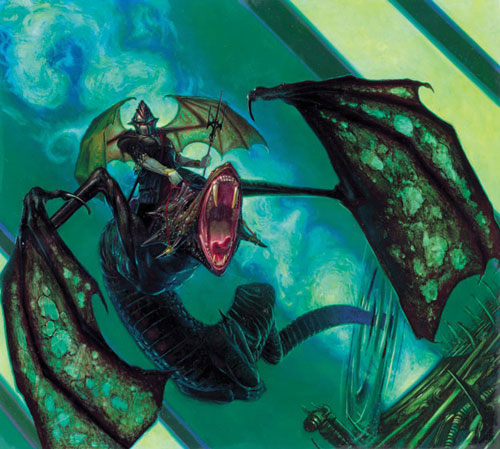
Doomsday Specter by Donato Giancola, 2001, oil on paper on masonite, 18” x 17”
I would love to show gigantic scans of all of Donato’s work, but that could be an entire article in and of itself and we would never get to the subject of today’s article. Check out his Magic art gallery on his website to see even more of his stunning work up close.
But there is one more thing that bears mention in this biographical section. In one of my first articles, I spoke about the Chesley Awards. The Chesley Awards are presented by the Association of Science Fiction and Fantasy Artists, or ASFA, and are akin to the Player of the Year/MVP in sports, a Grammy for music, or an Oscar for cinema, etc. The awards span ten different categories, as well as a Lifetime Achievement Award. For an artist to win one is a big deal and often a serious boon to their career, and to win multiple Chesley awards elevates an artist to the upper echelons of their field. Donato Giancola has won 23, including the Lifetime Artistic Achievement Award in 2002.
Twenty three.
His first came in 1997, winning in the Best Cover Illustration: Paperbacks category for “Eggheads,” and his most recent in 2017 for Best Product Illustration for his Illuxcon promotional piece “Portal.” You can see both pieces, created almost 20 years apart, below:
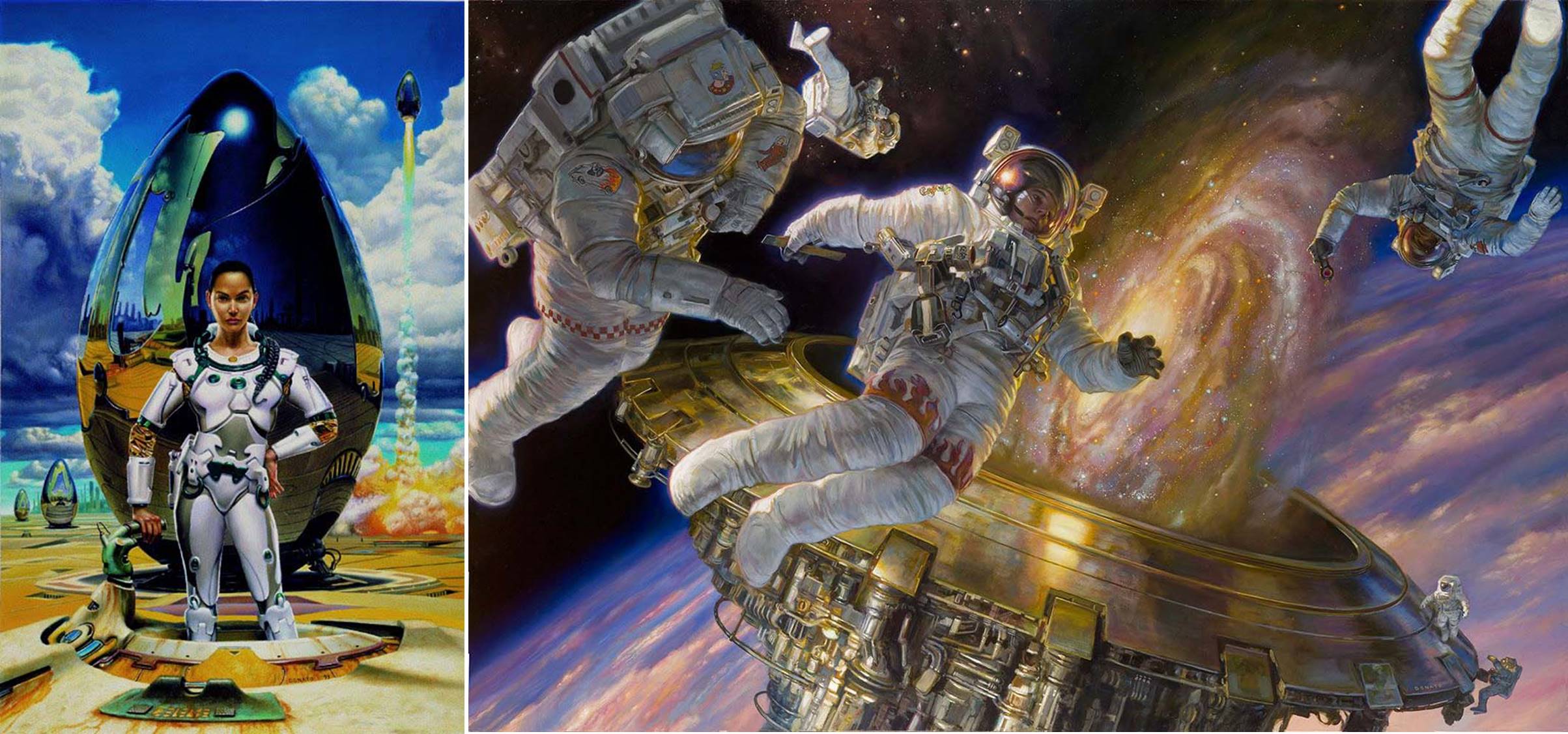
This sheer number of Chesley awards, accompanied by the Chesley Lifetime Artistic Achievement Award, is unparalleled, and a concrete testament to Donato’s talent as an artist. He is continually recognized for his craft, and his body of work over the last twenty five years is reflective of such honors. And the best part of all of this? He’s still painting, and the world will continue to benefit from his incredible imagination and creativity for years to come.
Of Panoramas and Polyptychs
Donato Giancola’s Basic Land Panorama is the latest in a long (but rare) line of panoramic and polyptych art in Magic: the Gathering. Before we go too much further, two definitions:
Panorama: An unbroken view of the whole region surrounding an observer.
Polyptych: A painting, typically an altarpiece, consisting of more than three leaves or panels joined by hinges or folds.
When I first began delving into original Magic art, someone shared a link in the MTG Art Market that linked to a Reddit thread that linked to an Imgur post that contained most of the panorama, diptych (two-piece), triptych (three-piece) and polyptych (multi-piece) pieces of Magic art. This link is by no means comprehensive, and I encourage you to browse the whole Imgur collection in its entirety, as well as Mike Linnemann’s article “What’s a Diptych?” for further art historical context. Most of these works are painted as panoramas, a single unbroken piece, but become multi-piece polyptychs once they are printed onto corresponding cards.The discovery of these pieces is half the fun, so I’ll just share a few highlights and personal favorites from when I first learned about them.
I began playing in Onslaught, and shortly after the game traveled to Kamigawa. What I didn’t know then, but know now, is the Kamigawa basic lands were all panoramas.
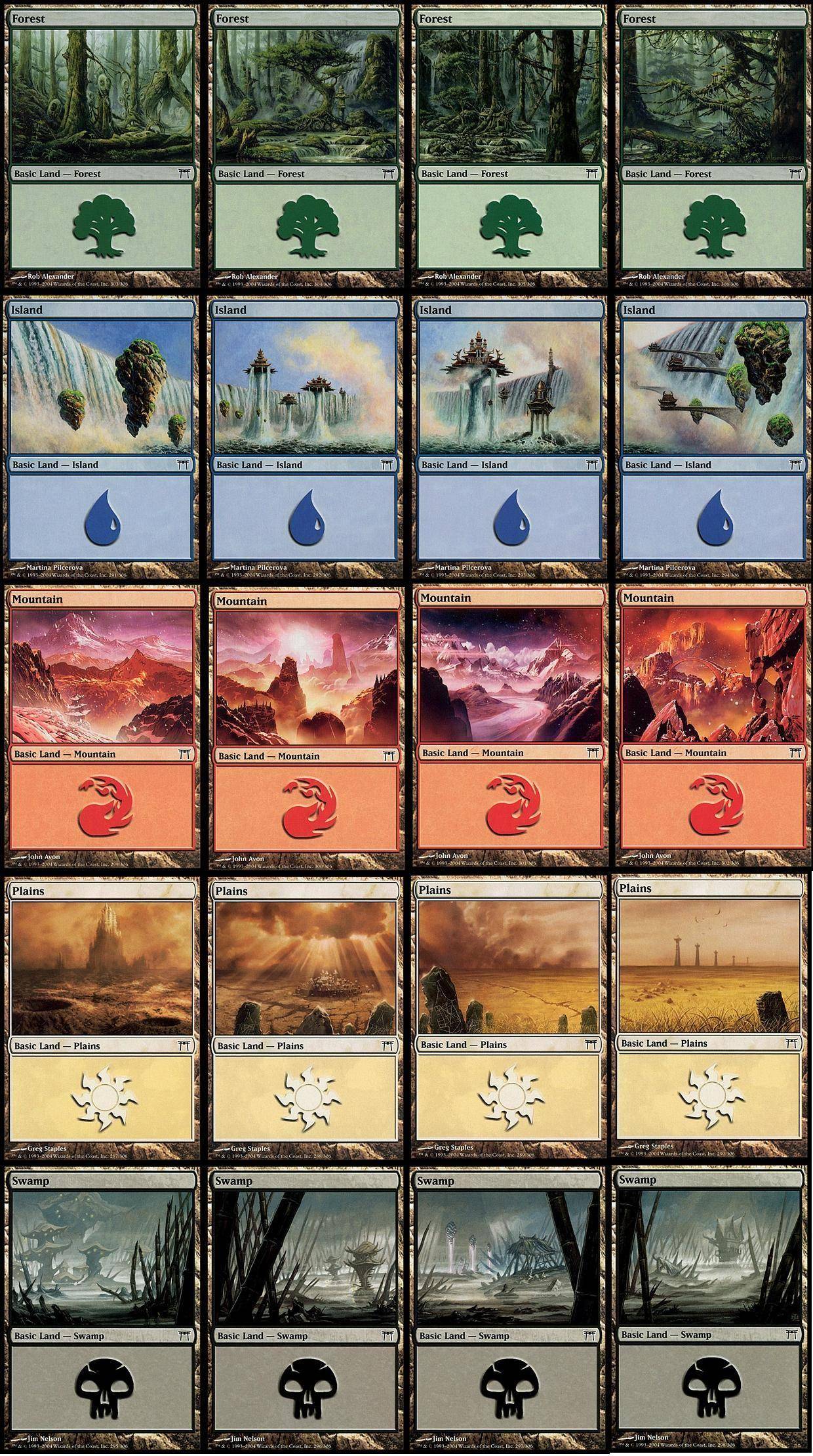
Then when I was an undergrad in college, Magic was on Lorwyn. Those basic lands are diptychs, and I know at least a few (if not all) of these are single paintings that then became two cards for printing.
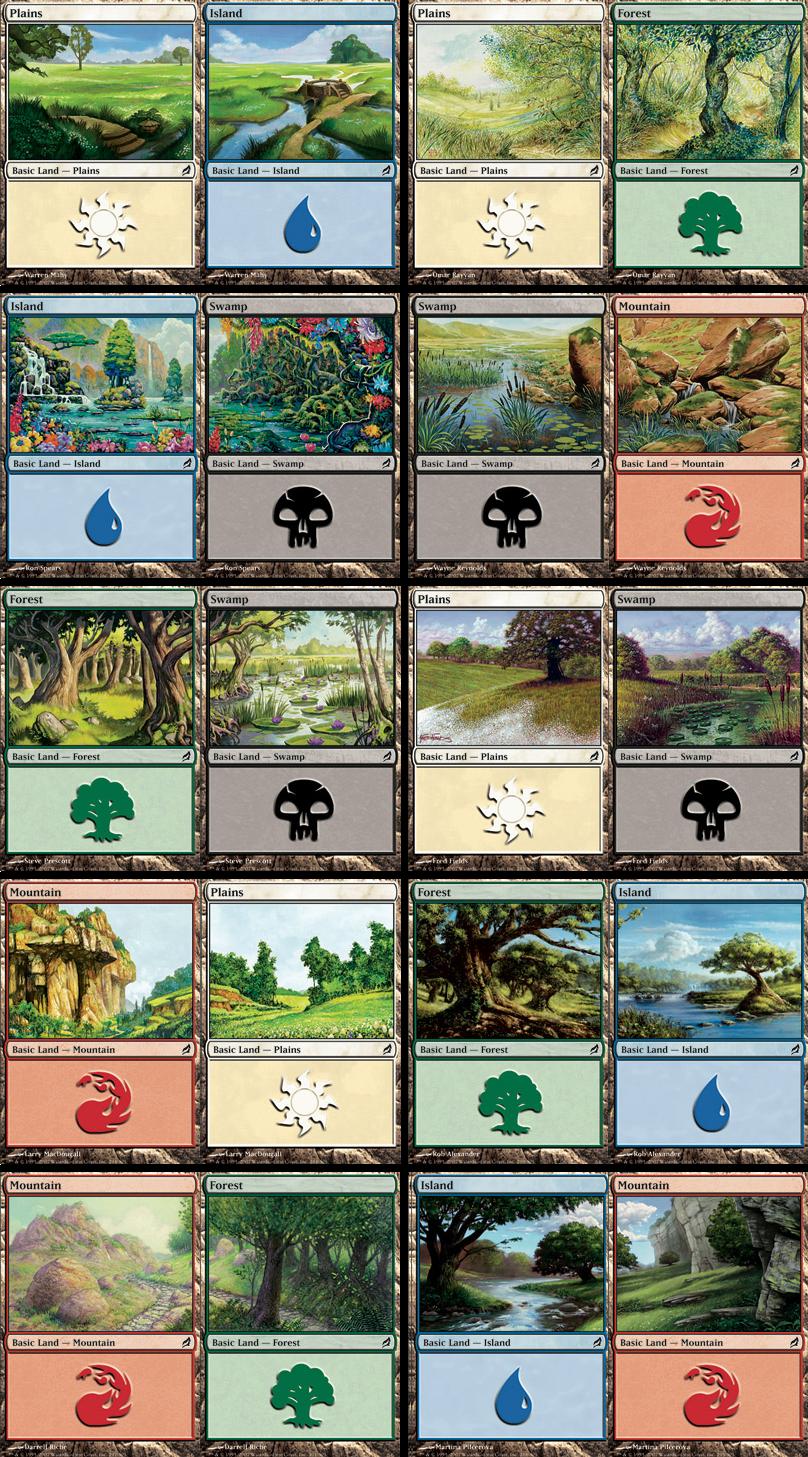
The same is true for the Shadowmoor basic lands below:
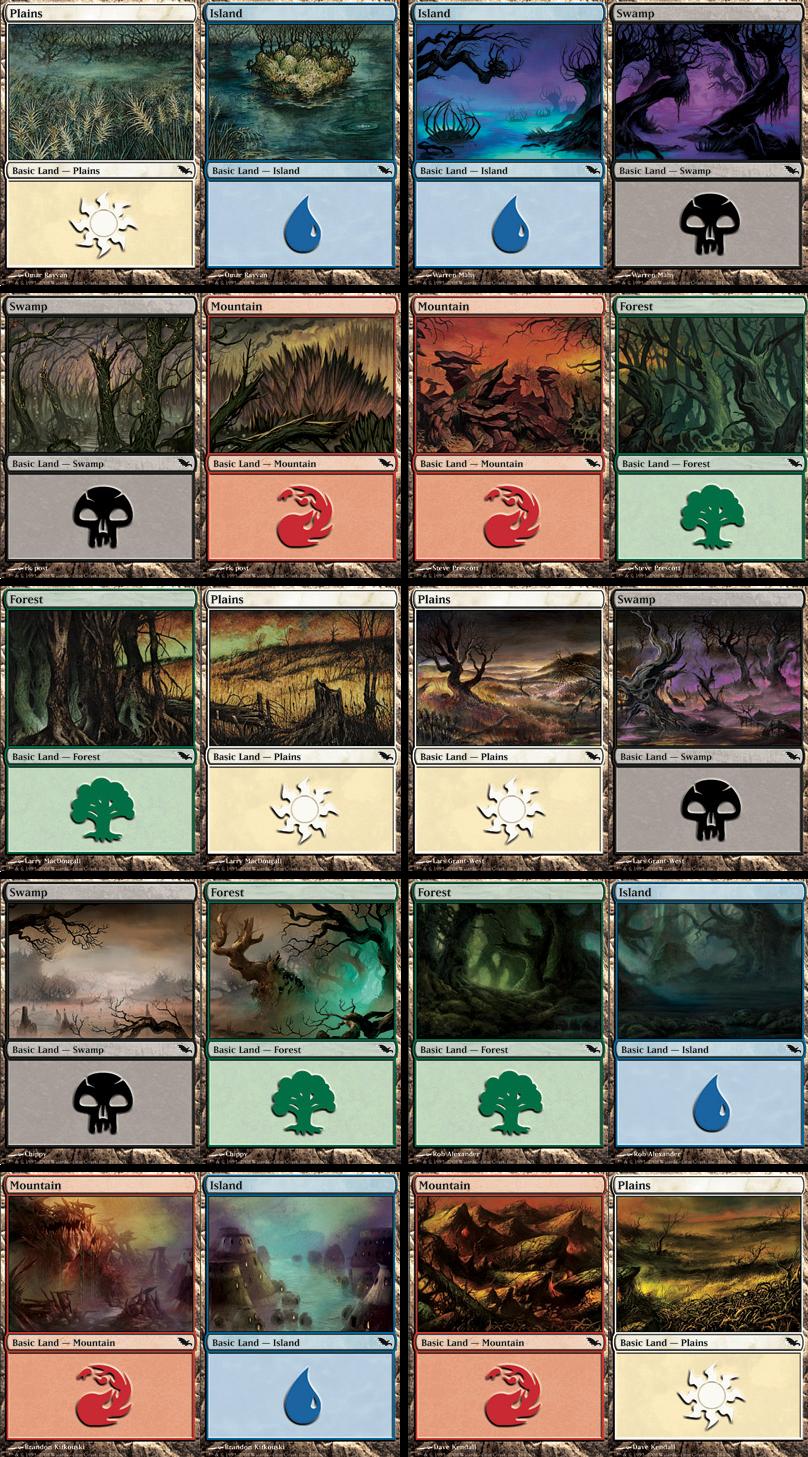
To compare apples to apples, or in this case promos to promos, we can’t forget Terese Nielsen’s Judge Promo Basic Lands, also a panorama.
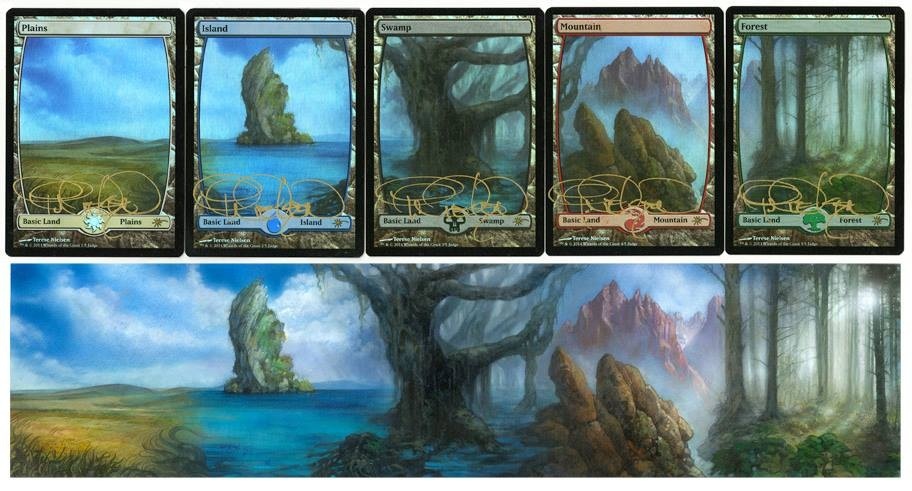
Or the Arena Promo Basic Lands that were some of the first in this style, as seen in 1996, 2003, and 2004.
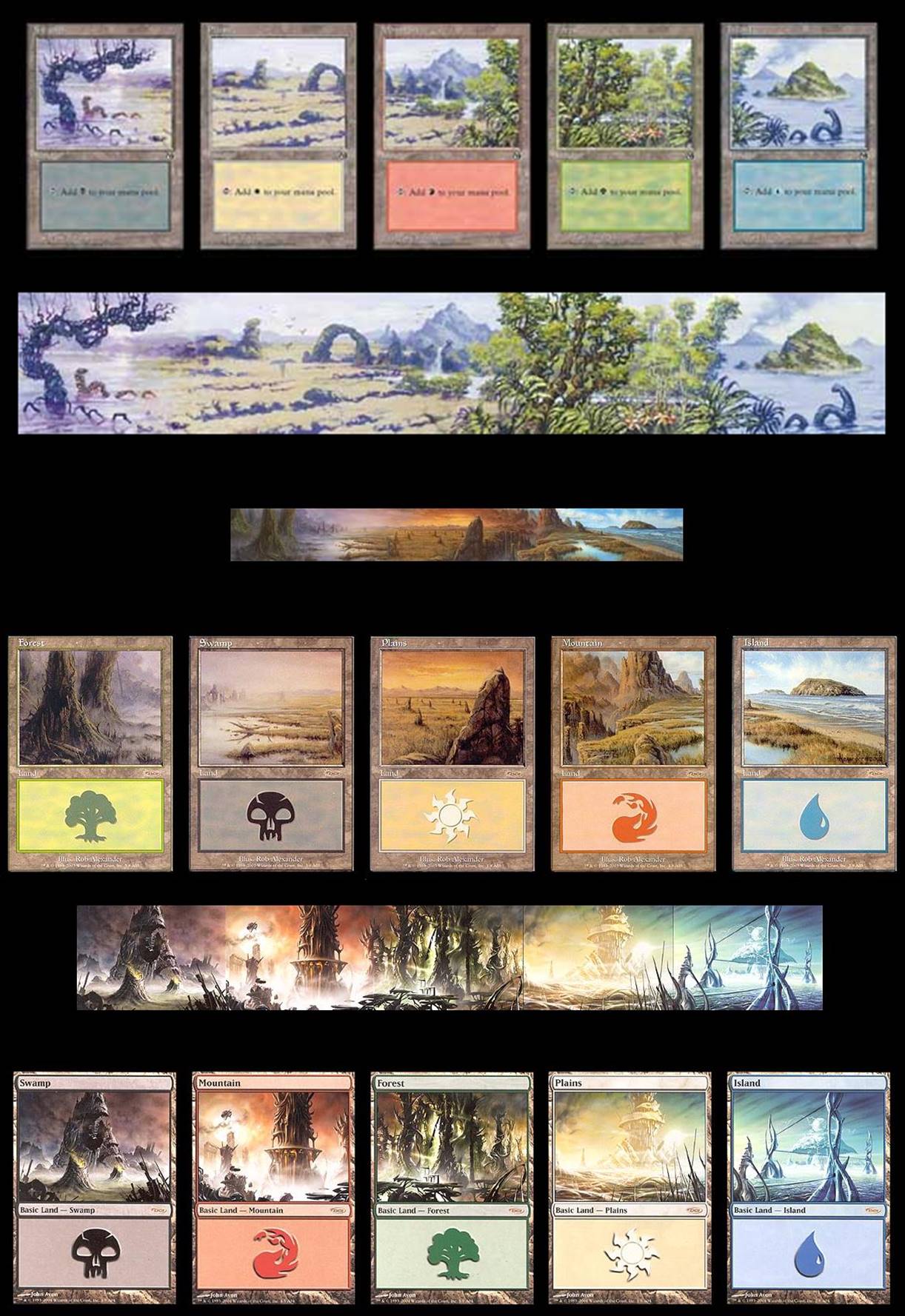
These are but a few examples, and again I encourage you to take a look for yourself. It’s an eye opening experience, and let me know some of your favorites on Twitter!
Why This Piece?
The Work
Panoramas and polyptychs are exceedingly rare in Magic, especially those comprised of all five basic lands. This is the first done by Donato, and this sketch is in his signature style of red pencil and chalk on toned paper. It is also the final version that the painting was based on; no sketch exists exactly as it was painted, as the forest and swamp were switched digitally for approval.
The Artist
Donato Giancola is one of the greatest artists to ever illustrate a Magic card, and his twenty three Chesley Awards are among a cavalcade of other honors and recognition that uphold this fact. Owning something by his hand will remain a pinnacle in my collecting career.
The Card(s)
Original artwork of basic land in any form is well sought after. Since this is a panorama of all five basic lands, it makes it particularly special, and I plan to gather at least a draft set of 10 of each land to use now that I own this piece of art.
Put it on the Wall!
This piece vaulted ahead in the framing backlog I currently have once it arrived, and not just because I was extra excited about it. Most of the unframed work I have is stored safely in a portfolio, but there just isn’t a good way to keep something of this size safe for an extended period of time outside of rolling it into a tube. This piece was framed along with last week’s Mirror Gallery work, Foxfire Oak, at the one and only Ain’t That a Frame in Westminster, Maryland.
One difference I knew before I even got there was that I was going to be using Tru-Vue Optium museum acrylic instead of glass. A bit more expensive, acrylic is safer for travel and provides the same super-clear, archival, and non-glare attributes as provided by Tru-Vue museum glass.
I knew I wanted to accent the grey toned background as well as the red watercolor pencil, and maybe even the chalk. We tried different metallic frames of gold and silver, and even some natural wood frame:
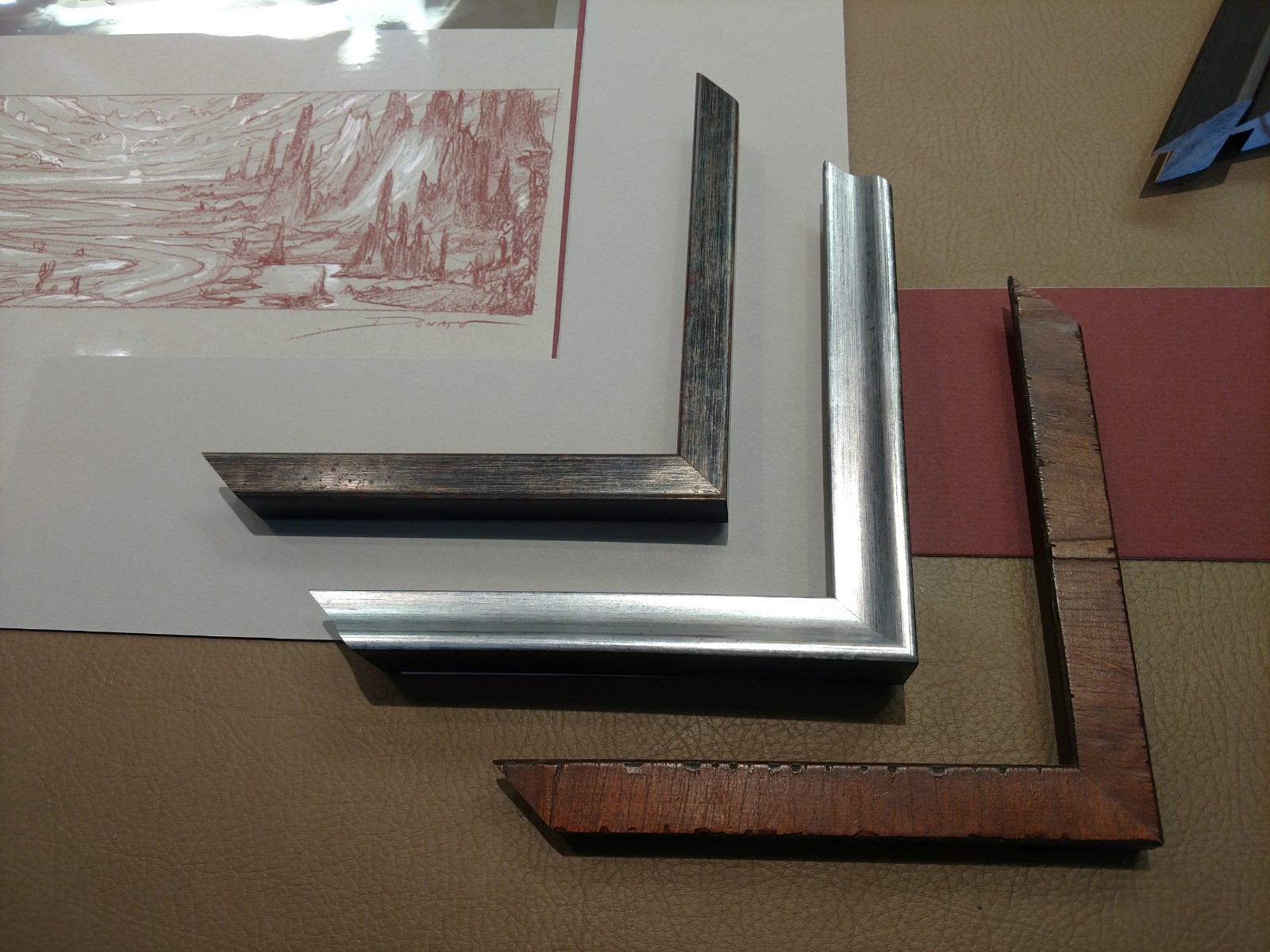
Before discovering this frame from the Oxy collection:
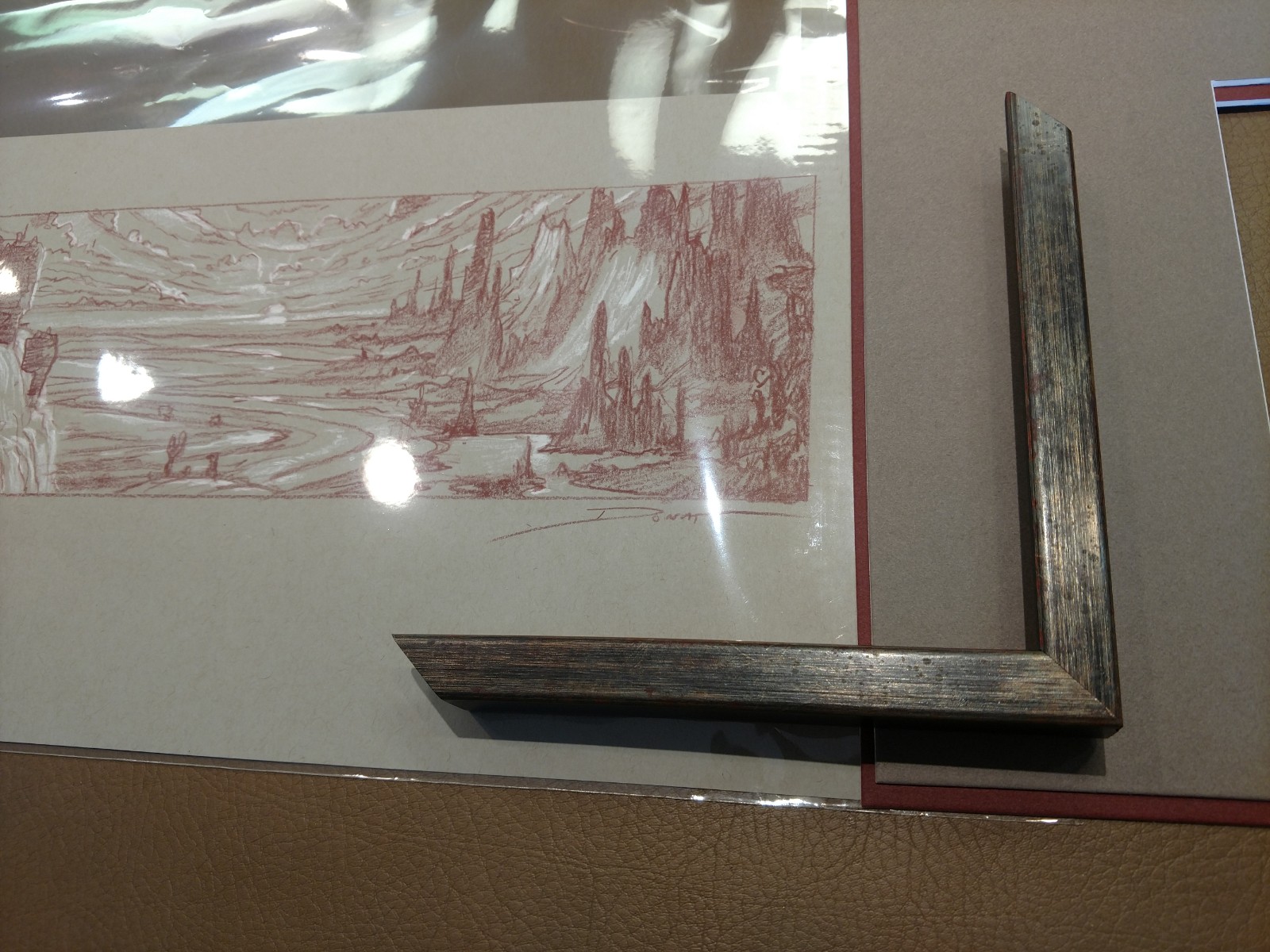
The frame appears as an oxidized black “cap,” with the reds and silver that show through the metallic exterior helping to accent the colored lines of the piece.
The major discussion for this sketch was what to do with the matte cores. Framing mattes by default show a white core, and this can help draw in the eye, or in some cases be incredibly distracting, depending on the piece. In the past I have always opted for back or reverse beveling, where mattes are placed color to color and there no white line:
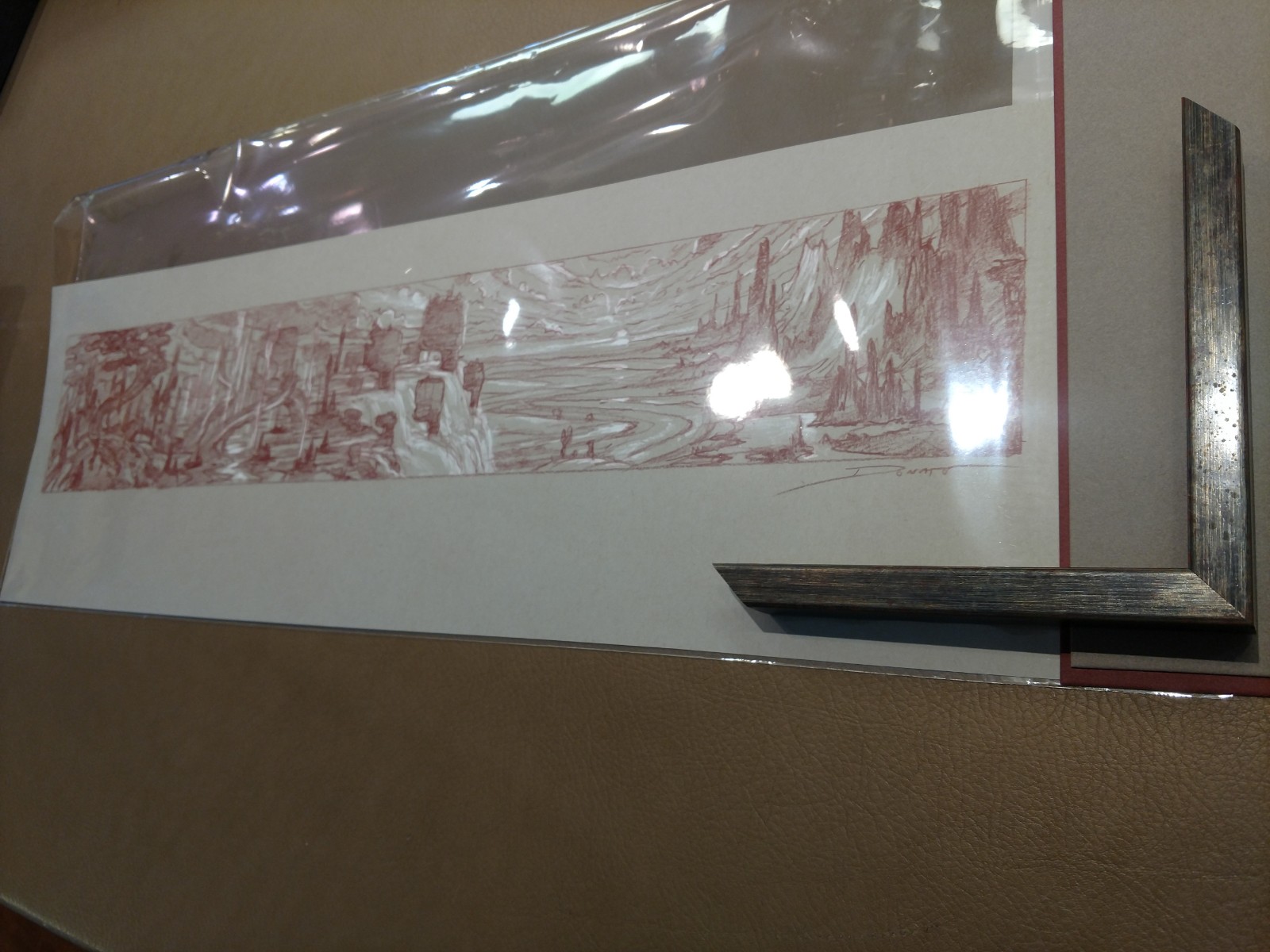
But for this piece, I thought the white core on one of the mattes, in this case the red one seen here, may help highlight the white chalk used in the drawing, and decided to give it a try.
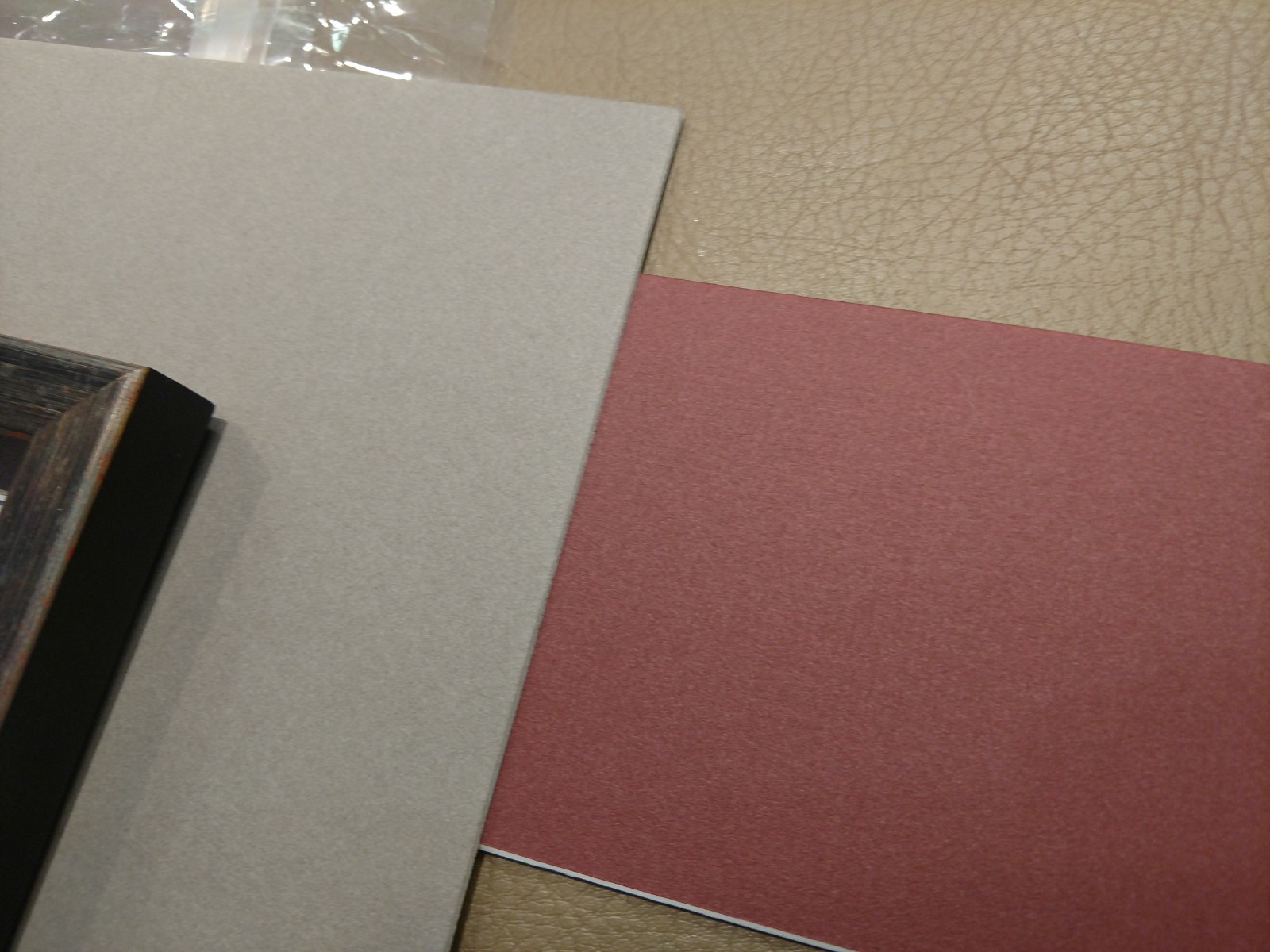
This next part is important. Over the last year I have built a relationship with Lou and the great folks at Ain’t That a Frame, and trust them implicitly with my artwork. While framing this piece, the white line from the exposed core of the matte was so overwhelming and overpowering it detracted considerably from the work. I was out of town and unavailable, and because we had already had the discussion and knowing my preference for reverse bevels, Lou and Andrew simply adjusted the framing plan and completed the piece without even having to call me. I’ve said it before, but I am ever so fortunate to have such great people at my local frame store; they are true professionals, and I’m lucky to now call them my friends in addition to my framers.
Here is the final result, in all of its beveled, matted and framed glory, and I couldn’t be any happier with how the ensemble came together.
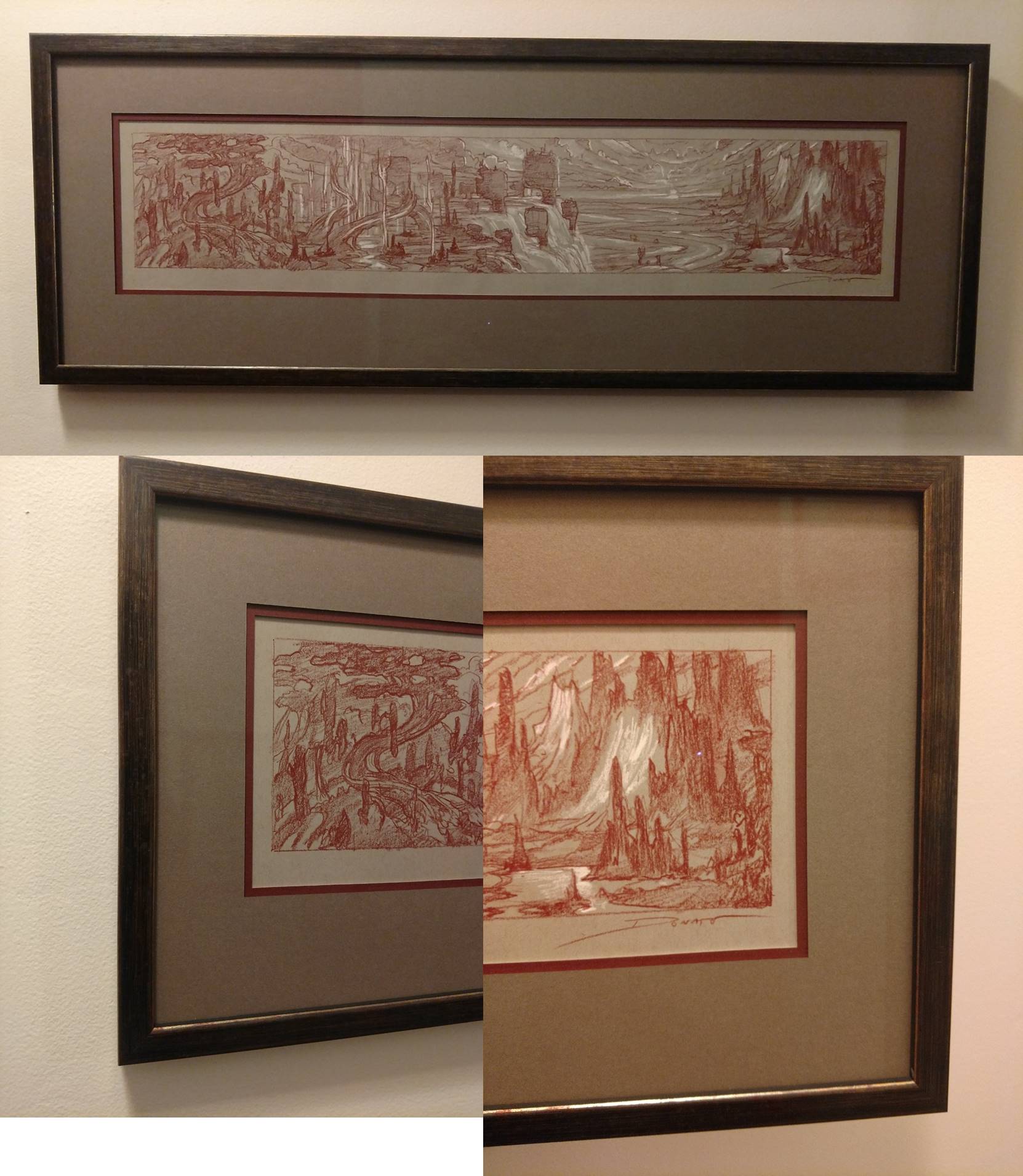
Build Your Collection
Donato has only a few pieces of his Magic work remaining for sale. His two most recent commissions, Foil and Iridescent Drake for Ultimate Masters, sold instantaneously. So the works below are the only standing options to acquire an MTG work directly from the artist:
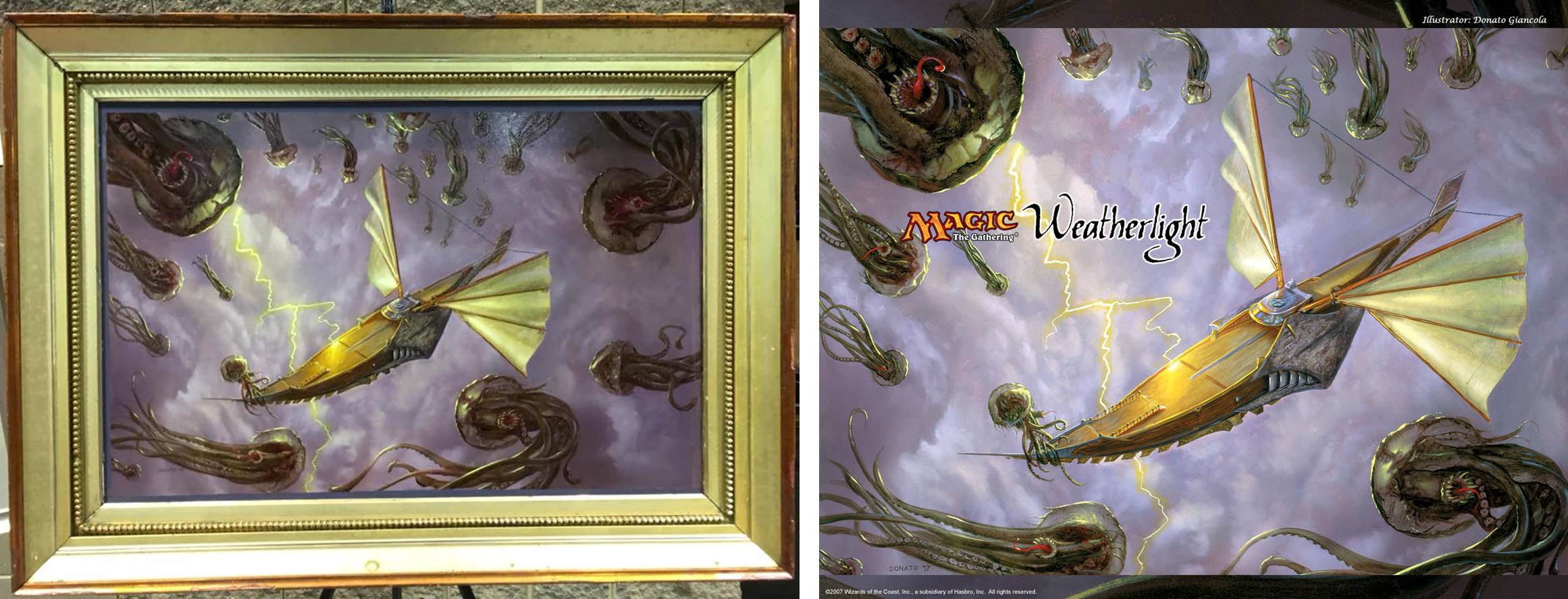
Weatherlight Advertisement, oil on paper on Masonite, 19” x 29” $18,000
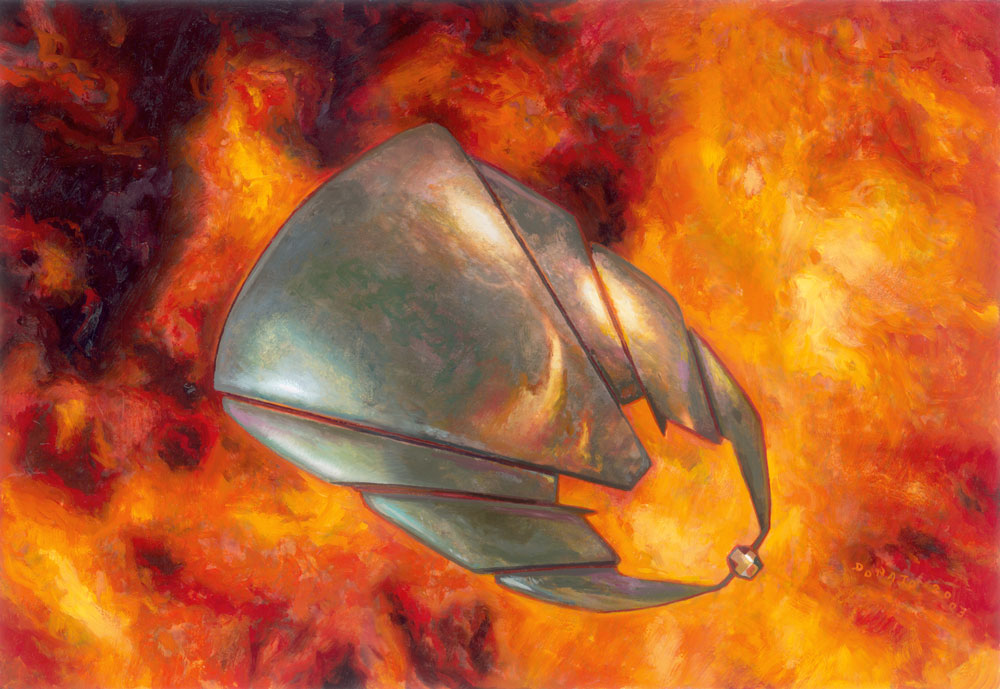
Shield of Kaldra, traditional in oils, $12,000
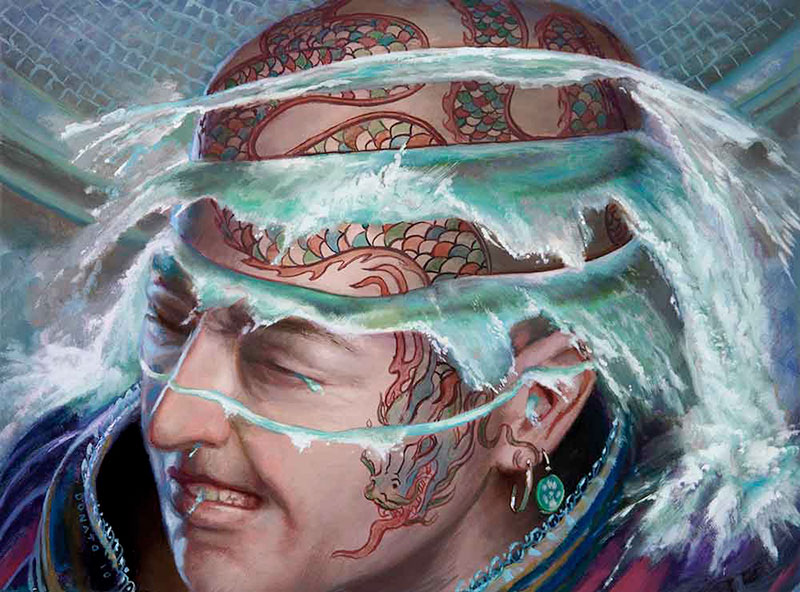
Perilous Research, traditional in oils, $7,000
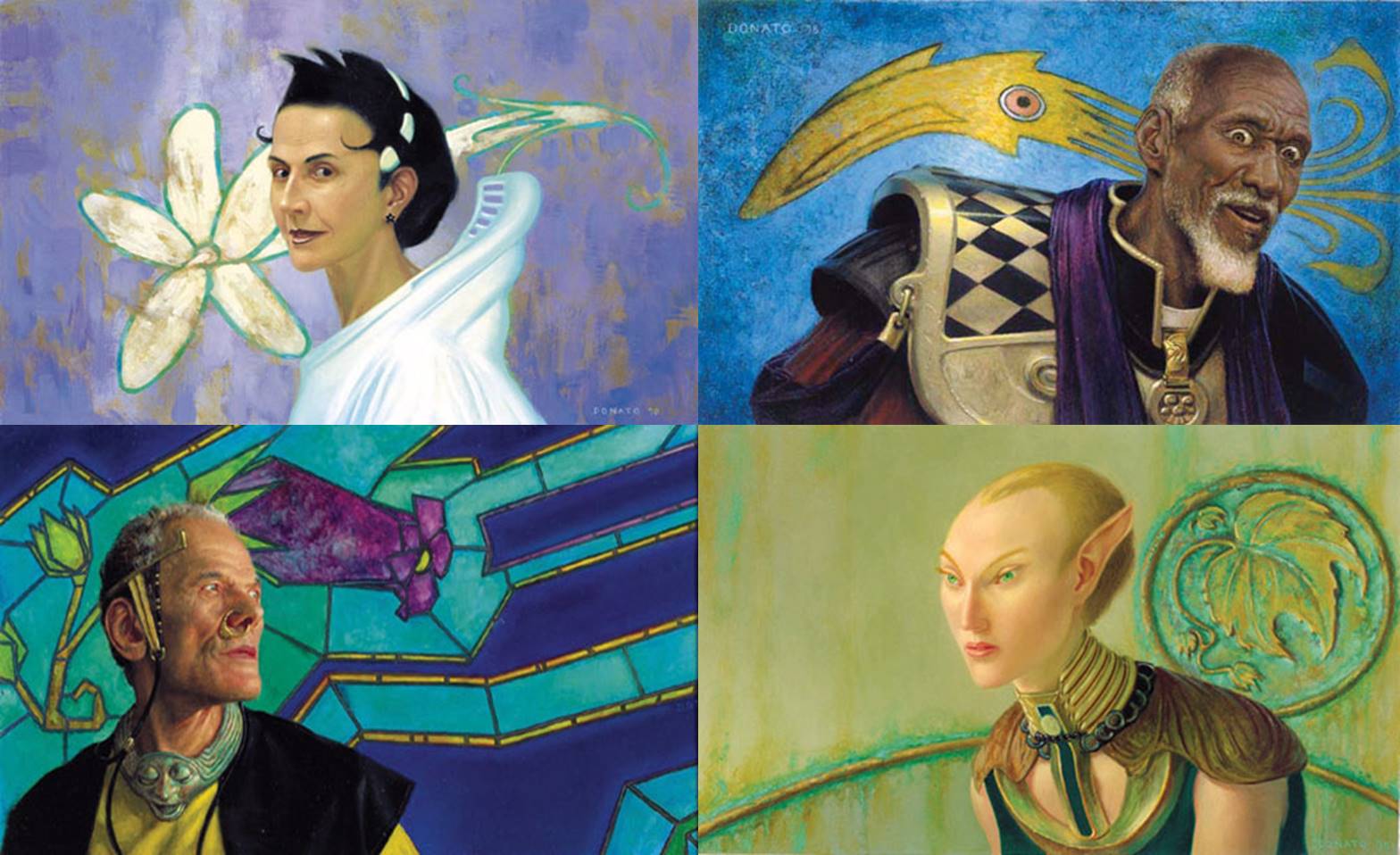
Brine Seer, Jasmine Seer, Ivy Seer, Nightshade Seer, all oil on paper on Masonite, 8” x 13” to 8” x 17” $9,000/ each
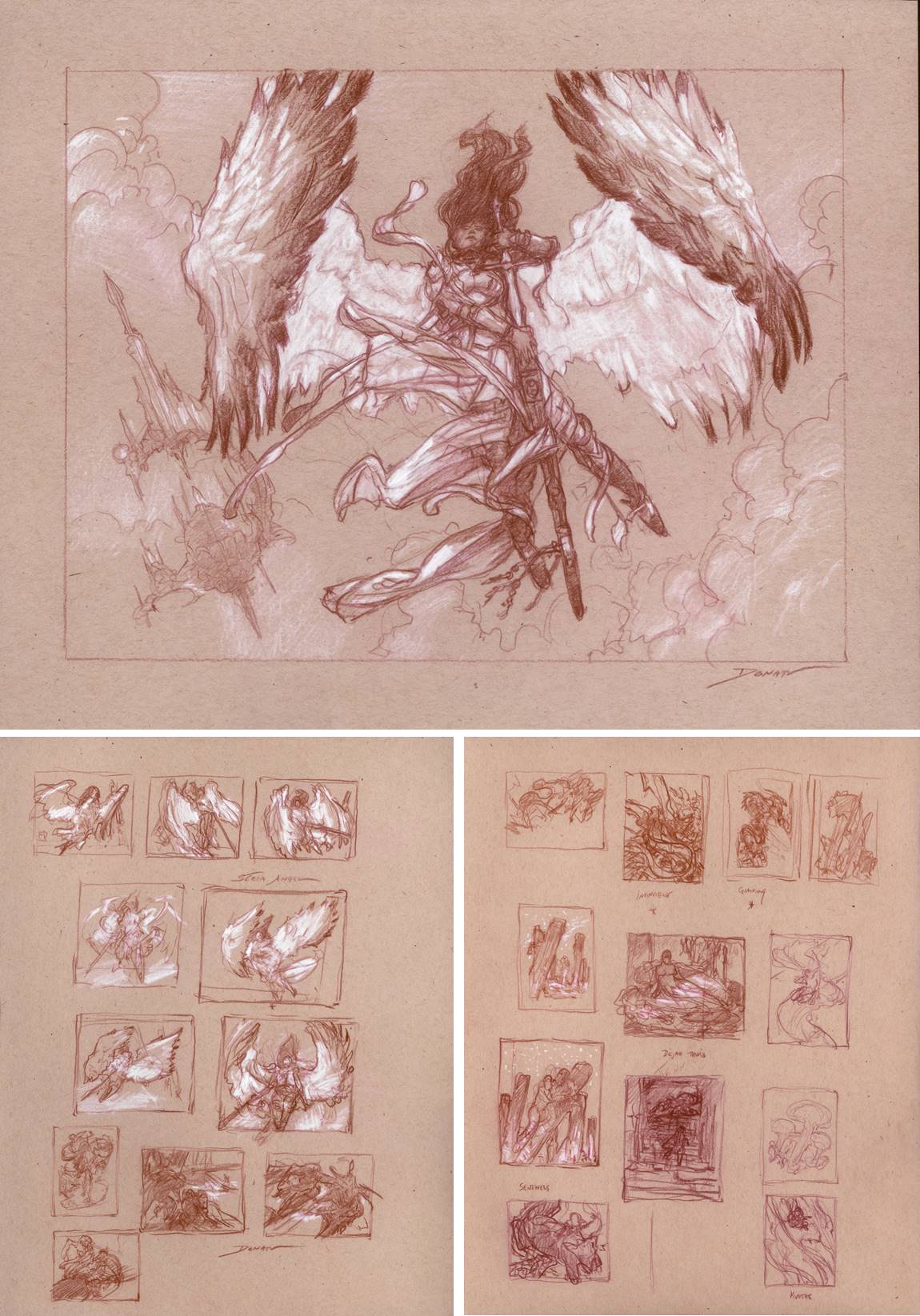
Serra Angel Preliminary sketch (unused) and thumbnails, watercolor pencil and chalk, two sheets 11” x 14” $1,500 as a set only.
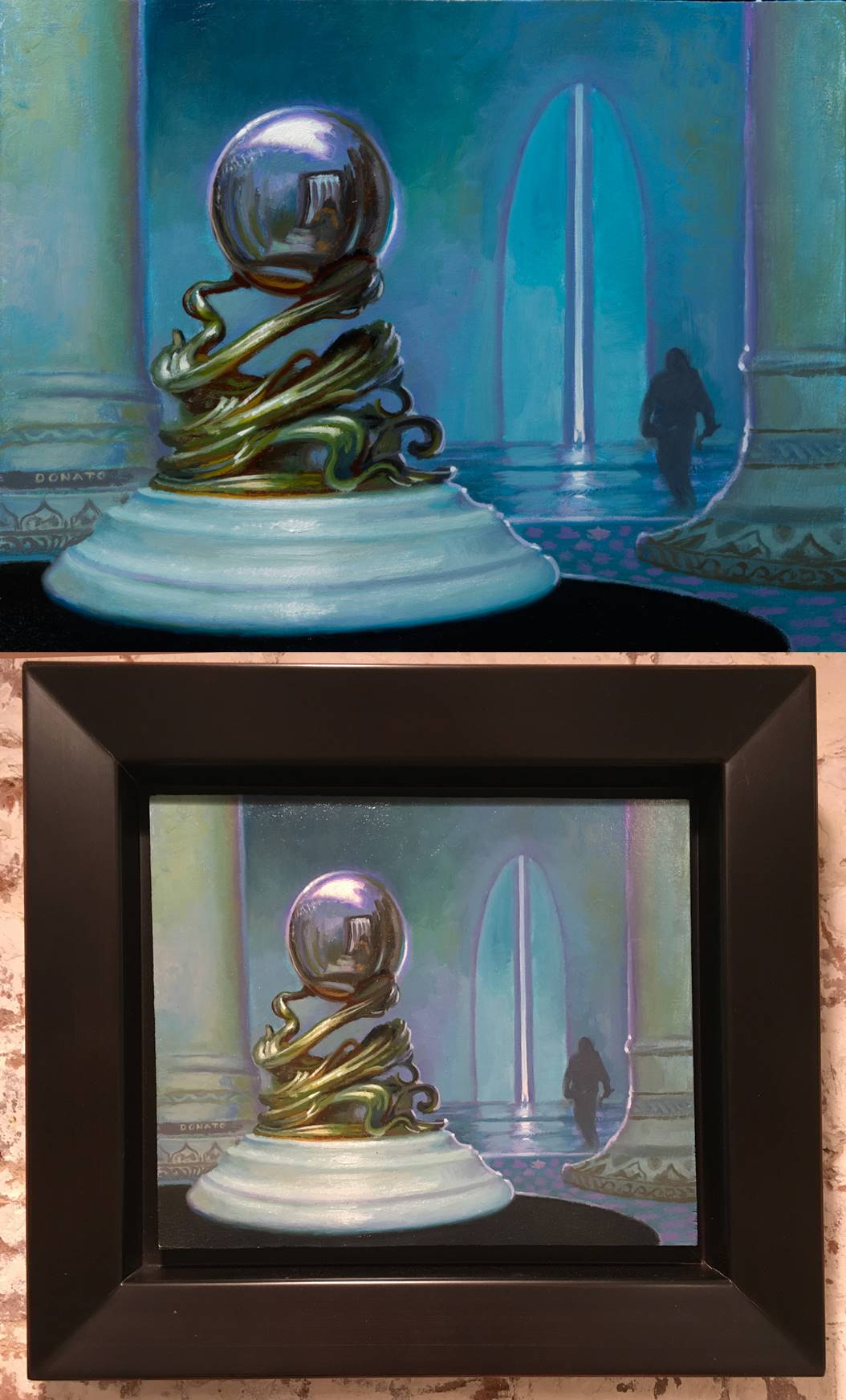
Mirari (2018 Repaint), oil on panel 8” x 10” framed to 13” x 15” #1 in an edition of 5 re-paintings, $2000.
The originals for Cabal Surgeon ($8,000) and Rack and Ruin ($9,000) are also still available according to Donato’s website, but there are no images of the entire art available at the time of writing. There is also a chance that he may still have the sketches or preliminaries for Foil and Iridescent Drake, but I don’t want to turn over all the stones for you; if you’re interested in anything you see or I’ve mentioned here, you can contact Donato via his website. He also has a full webstore with a variety of prints and proofs of his Magic and other work.
Wrapping Up
For a Magic art collector, owning a sketch by Donato Giancola is the equivalent of owning a page from DaVinci’s notebook. To have it be a panoramic sketch of basic lands, one of the signature subjects in the history of Magic art and in the scarcest style, is simply put, a privilege. This piece is one that will never leave my collection, and its acquisition story is one I’ve been very excited to share with you all. I can’t thank Donato enough for creating such a fabulous artwork, and for allowing me to collect this wonderful sketch and steward it for the next generation.
My last article of the year will be a Mirror Gallery Reflection: where we’ve been, how we got there, and where this column is headed into 2019. I hope you all will join me in two weeks, and until then I wish you all the happiest of holidays in whatever ways you choose to celebrate.
Remember, to see original #mtgart and other #vorthos related things, follow me on Twitter. Feel free to ask questions or retweet to continue the conversation. Thanks and see you next time!
Donny Caltrider has been playing Magic since 2002 and collecting original Magic art since 2017. He has an M.A. in Museum Studies from Johns Hopkins University and enjoys telling stories about art, objects, and the intersection of fantasy with real-life. You can find him on Twitter talking about #mtgart, museums, and other #vorthos related goodness. Follow along and continue the conversation!


